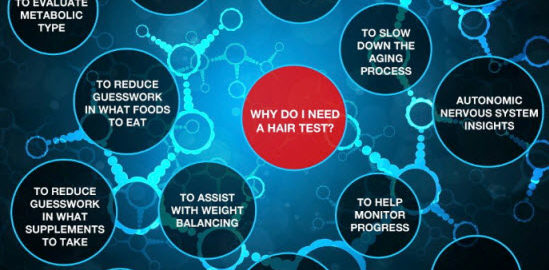Empower yourself with information about your heatlh

(The following services are not intended for diognostic purposes but to enable the client to determine the best possible state of their nutrition. )
WHAT IS HAIR MINERAL ANALYSIS?
Hair is used as one of the tissues of choice by the Environmental Protection Agency in determining toxic metal exposure. A 1980 report from the E.P.A. stated that human hair can be effectively used for biological monitoring of the highest priority toxic metals. This report confirmed the findings of other studies in the U.S. and abroad, which concluded that human hair may be a more appropriate tissue than blood or urine for studying community exposure to some trace elements
WHY USE THE HAIR? WHY NOT USE THE BLOOD?
Hair is ideal tissue for sampling and testing. First, it can be cut easily and painlessly and can be sent to the lab without special handling requirements. Second, clinical results have shown that a properly obtained sample can give an indication of mineral status and toxic metal accumulation following long term or even acute exposure.
A HTMA reveals a unique metabolic world: intracellular activity, which cannot be seen through most other tests. This provides a blueprint of the biochemistry occurring during the period of hair growth and development.
WHY TEST FOR MINERALS?
Trace minerals are essential in countless metabolic functions in all phases of the life process.
- Zinc is involved in the production, storage and secretion of insulin and is necessary for growth hormones.
- Magnesium is required for normal muscular function, especially the heart. A deficiency has been associated with an increased incidence of abnormal heart conditions, anxiety and nervousness.
- Potassium is critical for normal nutrient transport into the cell. A deficiency can result in muscular weakness, mild depression and lethargy.
- Excess sodium is associated with hypertension, but adequate amounts are required for normal health.
In the words of the late author and noted researcher, Dr. Henry Schroeder, trace elements (minerals) are “…more important factors in human nutrition than vitamins. The body can manufacture many vitamins, but it cannot produce necessary trace minerals or get rid of many possible excesses.”
WHAT CAN CAUSE A MINERAL IMBALANCE?
There are many factors to take into consideration, such as:
Diet – Improper diet through high intake of refined and processed foods, alcohol and fad diets can all lead to a chemical imbalance. Even the nutrient content of a “healthy” diet can be inadequate, depending upon the soil in which the food was grown or the method in which it was prepared.
Stress – Physical or emotional stress can deplete the body of many nutrients while also reducing the capability to absorb and utilize many nutrients.
Medications – Both prescription and over-the-counter medications can deplete the body stores of nutrient minerals and/or increase the levels of toxic metals. These medications include diuretics, antacids, aspirin and oral contraceptives.
Pollution – From adolescence through adulthood the average person is continually exposed to a variety of toxic metal sources such as cigarette smoke (cadmium), hair dyes (lead), hydrogenated oils (nickel), anti-perspirants (aluminum), dental amalgams (mercury and cadmium), copper and aluminum cookware and lead-based cosmetics. These are just a few of the hundreds of sources which can contribute to nutrient imbalances and adverse metabolic effects.
Nutritional Supplements – Taking incorrect supplements or improper amounts of supplements can produce many vitamin and mineral excesses and/or deficiencies, contributing to an overall biochemical imbalance.
Inherited Patterns – A predisposition toward certain mineral imbalances, deficiencies and excesses can be inherited from parents.
CAN VITAMIN REQUIREMENTS BE DETERMINED FROM A MINERAL TEST?
Minerals interact not only with each other but also with vitamins, proteins, carbohydrates and fats. Minerals influence each of these factors, and they, in turn, influence mineral status. Minerals act as enzyme activators, and vitamins are synergistic to minerals as coenzymes. It is extremely rare that a mineral disturbance develops without a corresponding disturbance in the synergistic vitamin(s). It is also rare for a disturbance in the utilization or activity of a vitamin to occur without affecting a synergistic mineral(s). For example, vitamin C affects iron absorption and reduces copper retention. Boron and iron influence the status of vitamin B2. Vitamin B2 affects the relationship between calcium and magnesium. Vitamin B1 enhances sodium retention, B12 enhances iron and cobalt absorption, and vitamin A enhances the utilization of zinc, while antagonizing vitamins D and E. Protein intake will affect zinc status, etc. Therefore, evaluating mineral status provides good clues of vitamin status and requirements. Continuing research at Trace Elements involves the recognition of many synergistic and antagonistic interrelationships between minerals and vitamins.
IS HAIR TISSUE MINERAL ANALYSIS SUPPORTED BY RESEARCH?
Hair tissue mineral analysis is supported by an impressive body of literature in a variety of respected national and international scientific publications. Over the past twenty-five years hair mineral testing has been extensive. Each year in the United States alone, federally licensed clinical laboratories perform over 150,000 hair mineral assays for health care professionals interested in an additional screening aid for a comprehensive patient evaluation. This does not take into consideration the thousands of subjects used in numerous continuing research studies conducted by private and government research agencies.
CONTACT ME FOR AN INITIAL CONSULTATION AND TO LEARN MORE ABOUT HOW I CAN HELP YOU.
